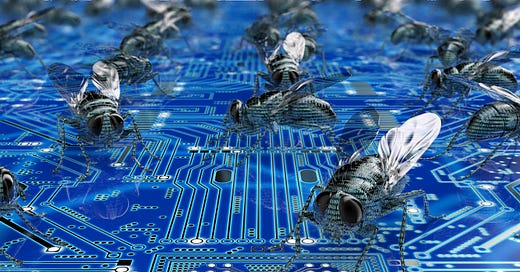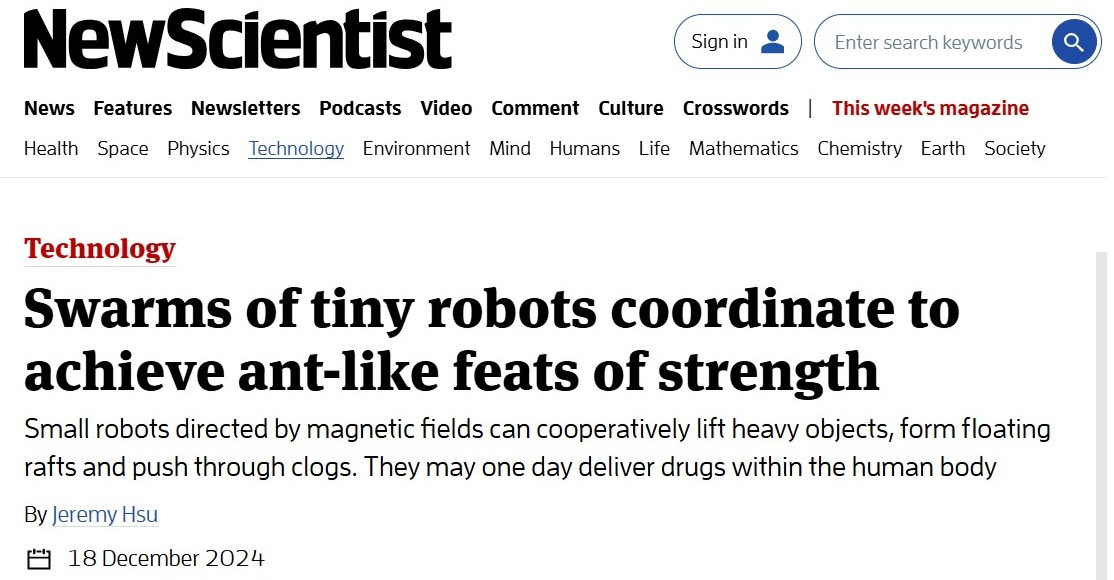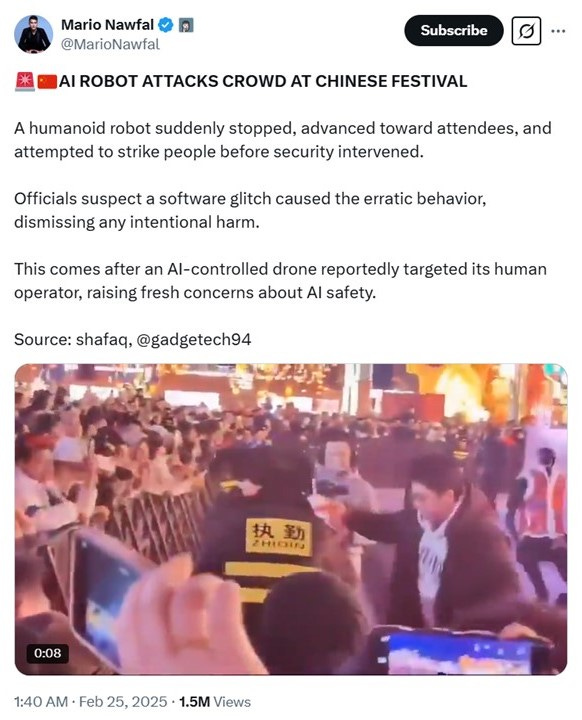Sometime soon, the world will transform overnight. As with the atomic bomb in August 1945, the sudden appearance of a new technology most never conceived possible will totally blindside the public.
How suddenly will the average person be blindsided? Almost overnight, if not literally overnight, they’ll go from ignorant of the possibility of the existence of new advanced military technologies to watching others use them to conquer the entire world and establish a global empire.
To help to visualize what’s coming, let’s take a look at some of the technologies developing right now…
Robot Pollinators or Something Else?
MIT is developing bug-sized robots, weighing less than a paperclip, and capable of completing acrobatic maneuvers such as double aerial flips. The given reason for creating such robots? A more efficient method for artificial pollination.
"With a more efficient method for artificial pollination, farmers in the future could grow fruits and vegetables inside multilevel warehouses, boosting yields while mitigating some of agriculture’s harmful impacts on the environment.
To help make this idea a reality, MIT researchers are developing robotic insects that could someday swarm out of mechanical hives to rapidly perform precise pollination. However, even the best bug-sized robots are no match for natural pollinators like bees when it comes to endurance, speed, and maneuverability.
Now, inspired by the anatomy of these natural pollinators, the researchers have overhauled their design to produce tiny, aerial robots that are far more agile and durable than prior versions."
According to the article, these robotic insects will “someday swarm out of mechanical hives to rapidly perform precise pollination.” Inspired by the anatomy of bees, researchers have completely redesigned prior versions to make these aerial robots magnitudes better than their predecessors.
"The new bots can hover for about 1,000 seconds, which is more than 100 times longer than previously demonstrated. The robotic insect, which weighs less than a paperclip, can fly significantly faster than similar bots while completing acrobatic maneuvers like double aerial flips.
The revamped robot is designed to boost flight precision and agility while minimizing the mechanical stress on its artificial wing flexures, which enables faster maneuvers, increased endurance, and a longer lifespan.
The new design also has enough free space that the robot could carry tiny batteries or sensors, which could enable it to fly on its own outside the lab."
While these robots are far superior to previous iterations, they still need to onboard batteries and sensors to fly outside of the lab. And despite recent innovations, the gap has yet to be closed between the capabilities of the robot insects and their real-world counterparts. But have no doubt, that gap will be closed.
"Yet even with these design innovations, there is still a gap between the best robotic insects and the real thing. For instance, a bee has only two wings, yet it can perform rapid and highly controlled motions.
'The wings of bees are finely controlled by a very sophisticated set of muscles. That level of fine-tuning is something that truly intrigues us, but we have not yet been able to replicate,' he says."
So the goal is to create robot insects indistinguishable from the real thing. Do you think the only purpose of such robots is artificial pollination? Do you really think the ultimate goal is nothing more than higher crop yields?
A Major Healthcare Breakthrough or Something Else?
Researchers have created swarms of tiny robots collaborating in tandem like ants. The given reason for creating them? Better healthcare delivery.
Swarms of tiny robots guided by magnetic fields can coordinate to act like ants, from packing together to form a floating raft to lifting objects hundreds of times their weight. About the size of a grain of sand, the microrobots could someday do jobs larger bots cannot, such as unblocking blood vessels and delivering drugs to specific locations inside the human body.
Jeong Jae Wie at Hanyang University in South Korea and his colleagues made the tiny, cube-shaped robots using a mould and epoxy resin embedded with magnetic alloy. These small magnetic particles enable the microrobots to be “programmed” to form various configurations after being exposed to strong magnetic fields from certain angles. The bots can then be controlled by external magnetic fields to perform spins or other motions. This approach allowed the team to “efficiently and quickly produce hundreds to thousands of microrobots”, each with a magnetic profile designed for specific missions, says Wie.
The researchers directed the microrobot swarms to cooperatively climb over obstacles five times higher than any single microrobot and form a floating raft on water. The bots also pushed through a clogged tube and transported a pill 2000 times their individual weight through liquid, demonstrating potential medical applications.
“These magnetic microrobots hold great promise for minimally invasive drug delivery in small, enclosed and confined spaces,” says Xiaoguang Dong at Vanderbilt University in Tennessee, who was not involved in the research. But the microrobots cannot yet autonomously navigate complex and tight spaces such as arteries.”
Swarms of microrobots capable of moving objects hundreds of times their collective weight… Do you think their capabilities will only be limited to the healthcare field?
Household Chores or Something Else?
Meta (more commonly known as Facebook) is investing in humanoid robots they say will be trained to perform household chores.
Bloomberg reports that Mark Zuckerberg's Meta plans to invest in futuristic robots that can perform human tasks. This initiative will be under a new team formed within its Reality Labs hardware division, according to sources familiar with the investment.
The humanoid robots will be trained on the most typical household chores.
Here's more from the report:
Meta plans to work on its own humanoid robot hardware, with an initial focus on household chores. Its bigger ambition is to make the underlying AI, sensors and software for robots that will be manufactured and sold by a range of companies, said the people, who asked not to be identified because the initiative hasn't been announced.
Meta has started discussing its plan with robotics companies, including Unitree Robotics and Figure AI Inc.
Meta's dive into humanoid robots mirrors Elon Musk's Tesla Optimus, a bi-pedal, autonomous humanoid robot designed to complete unsafe, repetitive, or boring tasks.
Do you think legions of humanoid robots will only be trained for household chores? Think again. They could easily be reprogrammed to attack humans. Just check out this video from X (formerly Twitter):
If a software glitch can lead to a robot attack, would you want one of those robots in your home? Do you really think humanoid robots will be limited to performing domestic chores?
The Future of Warfare
These news stories provide just a glimpse into the future of warfare. We’re only in the earliest stages of military drone and robot development. Artificial Intelligence (A.I.) will play a significant role in transforming today’s drones into a new generation of smaller, lighter, faster, and stronger vehicles. Some drones today operate in what the media calls “swarms,” but again, these swarms are only a shadow of what’s to come. As A.I. progresses, we’ll see larger swarms of decentralized drones operating in tandem on the battlefield.
These synchronized drones are the future of warfare. If you want to know where the world is going, think about it like this... Have you ever seen a large flock of birds flying in unison? They look like a cloud. And the whole flock can shift left, right, up, or down – all in a split second. Despite their quick shifts, these birds act as one. They aren’t disorganized or disjointed. They fly in perfect harmony as if they have a single mind. We observe similar behavior in schools of fish, bees, locusts, gnats, and all sorts of animals.
Now, imagine one of these groups is coming to get you. If a swarm of bees is coming to get you, would a shotgun do you any good? No. You can fire into a swarm of bees, and you might take out a few. But the swarm will keep coming. This is because the power of a swarm is decentralized. A single strike on any part of the swarm (if it manages to do any damage at all) won’t stop the swarm.
Does this sound scary? It should. This is the future of warfare. As technology advances, synchronized drones will get smaller and smaller, faster and faster, and ever more powerful. In the near future, one nation will use them to attack a nation only armed with conventional weapons. What do you think will happen when combat drones traveling like a swarm of bees attacks a conventional army? How effective will tank fire or heat seeking missiles be when directed at a swarm? That’s right. They’ll be just as effective as firing a shotgun at a swarm of bees.
This work is a full-time endeavor for our family. Without the support of readers, viewers, and listeners like you, the work we do here would not be possible. If you like what you see, please consider becoming a paid subscriber.
As a paid subscriber, you’ll get weekly paid-subscriber videos and/or articles, a monthly live Q&A via Zoom, commenting privileges on every post, access to the complete archives, and more. Most of all, you get to support this work which spreads the Good News of Jesus Christ to tens of thousands of people in over 100 countries.
This Wall Street Journal headline illustrates what’s coming (and it’s still only showing a rendering of an early-stage drone swarm attack):
This is where our world is headed. Those nations that first develop swarm technology will rule over those nations slow to adapt. History has proven this lesson time and again. Charging columns of soldiers were effective once – until machine guns arrived. Racing soldiers on horseback were once effective too – until armored tanks arrived. We can all cite countless examples of new military technologies making tried-and-true weapons and tactics obsolete. The same will prove true with swarm technology. And it will completely transform the world’s current balance of power.
If you’re struggling to visualize what this type of warfare will look like, I highly recommend watching this video:
It should be clear by now, decentralized drone swarms controlled by A.I. are the future of warfare. Many of these drones act as expendable munitions – that is, as suicide bombs. They blow themselves up as they reach their targets.
This changes the nature of weapons development and military production. Instead of taking a decade (and billions of dollars) to develop a sophisticated piece of high-end conventional hardware, the militaries of the world will seek to develop expendable drones at as low of a cost as possible. Billions of dollars will be poured into developing the software and A.I. systems to control those drones rather than the drone hardware itself. In doing so, whoever can manufacture the most drones at the lowest cost in the shortest timeframe will have an enormous advantage. This is evidenced by what we see governments doing right now. A race is underway to develop drones at scale on the battlefield. And the nation that achieves the coming breakthrough will have an insurmountable advantage.
Scaling Up Military Power
Within a few short years, the sophistication of A.I.-controlled drone swarms will far exceed anything we see today. Most conventional weapons will be powerless against them. But Mutual Assured Destruction (MAD) will not be overturned until drone swarms can be quickly deployed at scale and at relatively low cost.
Once humanity achieves the breakthrough enabling this, it will radically alter the current world order. Such a breakthrough will result in several unavoidable consequences. One of those is the ability to conquer the globe.
In 2017, Vladimir Putin pointed this out while addressing a group of college students. Referring specifically to A.I. (but also the other advanced technologies A.I. will help facilitate), he said:
“Whoever becomes the leader in this sphere will become the ruler of the world.”
According to Vladimir Putin, the leader in artificial intelligence will conquer the world. What he doesn’t state, but implies, is this means the end of MAD. As long as MAD remains in place, ruling the world through military conquest is impossible.
But Putin says such a global empire is coming. He implies one nation (or group of nations) will rule the world. In fact, he knows it. Other world leaders know it as well. Don’t doubt it, this was not an offhand remark.
It was a public admission of an ongoing race – a race to develop A.I. and other advanced technologies at scale. In this race, no one gets a silver medal. The second place nations get nothing. The first place nation gets the whole world. Do you understand now why the world is about to change forever and why most people have no idea what’s coming?
What the Bible Says
Those who study bible prophecy have long known a global empire is coming. They know what the Bible predicts for the end times. It says a global empire will exist, one that rules every person on earth (Revelation 13:7). This empire will crush and devour the whole world (Daniel 7:23). And when it does, it will control almost every aspect of human life – to the point of determining “who can buy and who can sell” (Revelation 13:17).
According to Vladimir Putin, the leader in A.I. will set up this global empire, but the technologies in question include more than just A.I. They include quantum computing, swarm technologies, and other advancements. Most importantly, they include the most powerful of all the coming advanced technologies. So have no doubt, a race is on right now, and it will soon result in the global empire the Bible foretold.
It’s just one more sign of the times in which we live. Jesus is coming!
If you liked reading this, please click the ❤️ button on this post so more people can discover it on Substack 🙏 or share it with your loved ones and spread the Good News that Jesus is coming!












COME LORD JESUS COME!🙏
Oh yes. These types of changes are only a sampling.
The robot insect pollinators, good, but likely to be used to vaccinate us.
Tiny healthcare robots; you'll never know they're in us.
Humanoid robots, ha, these are the personalized AI Agents designed for each one of us...you thought Siri or Alexa was intrusive.
Drone swarms for war, very soon, likely to be used to control us, the masses.
When all of the above are self-replicating, it's all over. Take us home, Jesus.
Convergence is on the way; the Technocracy aka New World Order with Antichrist.
Like you've said before Britt it's coming with exponential speed.